The Great Debate: DTC vs Marketplaces
A Webinar With Cahoot, BigCommerce, Tinuiti, and ChannelAdvisor
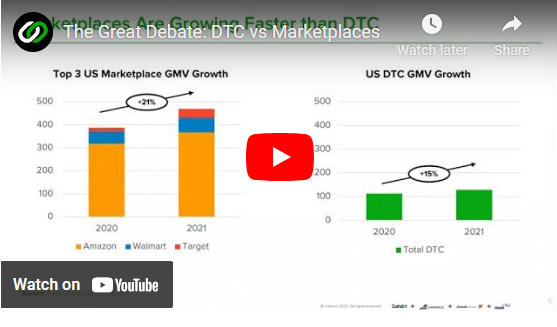
Should you focus on marketplaces, a DTC site, or both?
In a lively webinar, Cahoot brought together market leaders for a friendly debate on where you should sell and how to maximize results once you’ve made your choice.
BigCommerce advocated for DTC sites and provided the latest insights on how to win when building a brand.
ChannelAdvisor provided the marketplace’s perspective and gave attendees the tools you need to boost growth on Amazon, Walmart, and more.
And because it doesn’t have to be one or the other, Tinuiti and Cahoot shared advice on how to fine-tune your advertising and operations strategy to win with a multi channel ecommerce strategy.
Contents
- The State of Multichannel Ecommerce
- Why Should You Sell on Marketplaces?
- Why Should You Have a DTC Site?
- How Can You Grow With Multichannel Ecommerce?
- Why You Need to Close The Order Fulfillment Gap
The State of Multichannel Ecommerce
A rising tide lifts all boats – and US ecommerce spending is a rapidly expanding ocean. Spurred by the COVID pandemic, online spending in the country has surged to $870 billion dollars in 2021, up $108 billion over 2020 (DigitalCommerce360).
Many have benefited, from the biggest players like Amazon to small DTC brands opening up their own stores. The spread of spending is far from equal, though. In short, the big marketplaces capture an outsized share of US ecommerce spending, and they’re actually increasing their share.
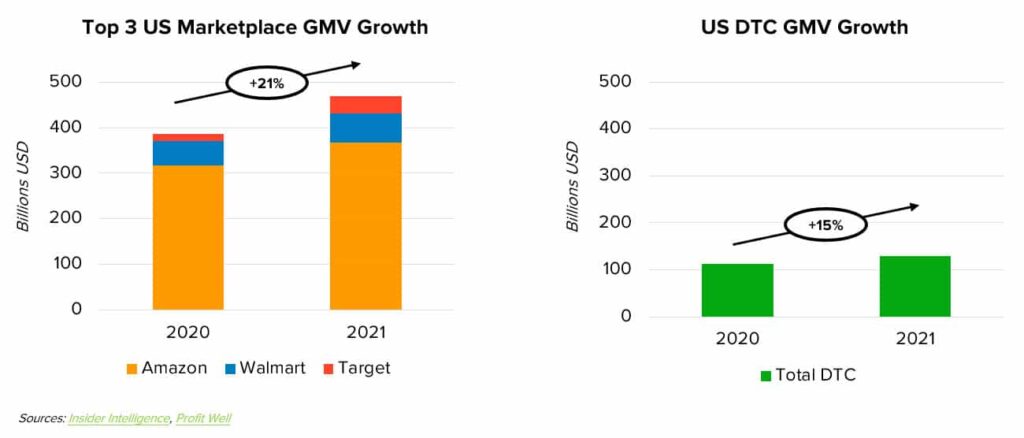
Just the top three online marketplaces (Amazon, Walmart, and Target) combined make up over half of US ecommerce spending. Collectively, they grew 21% in 2021 when compared to 2020 – beating overall ecommerce spending’s growth rate.
In contrast, estimates peg total direct-to-consumer (DTC) ecommerce spending at ~$125 billion, up 15% in 2021 over 2020. A huge number of new brands and small businesses alike are opening up webstores, but they collectively are about a quarter of the size of the big marketplaces. On top of that, they’re growing more slowly – so the gap is growing, not shrinking.
What explains the incredible dominance of the marketplaces?
Cahoot’s original study released with Forbes found that top DTC brands let marketplaces beat them on price and delivery experience for their own products. Our study was simple: we compared the prices of popular products on a list of top DTC sites to the prices of the identical products on marketplaces. More often than not, the offer on the marketplace has a lower price and faster shipping.
Manish dove into an example from the great beauty brand Olaplex to drive the point home. They’ve built an incredible brand, and they’ve cultivated a community of loyal shoppers that swear by their products. Those products, though, are more expensive and ship slower on their own store than they do on Amazon and Walmart:
According to our good friends at ChannelAdvisor, well over half of all eCommerce searches start on Amazon. We’re willing to bet that a large portion of Olaplex’s loyal customers actually buy their go-to products from Amazon and Walmart instead of Olaplex, costing the brand significant margin.
The marketplaces take a 5-15% referral fee, and every search on a marketplace serves up competitive options. So not only is Olaplex earning much less profit per sale on the marketplaces, but they’re also losing the opportunity to create lifelong customers.
We don’t mean to pick on Olaplex. In fact, among a sample of popular products from our list of 50 top brands, the marketplaces are cheaper ~60% of the time.
This data isn’t ambiguous. Amazon and Walmart consistently win the price war against DTC sites for their own products, grabbing customers that could be bolstering the brand’s bottom line. On top of that, even when the brands offer a better or the same price, they’re delivering items more slowly than Amazon Prime and Walmart Plus.
Though they’re both vitally important, a lot more goes into a customer’s purchasing decision than price and delivery experience. To learn more about why people love ecommerce marketplaces so much, and why they’re so beneficial for 3rd party sellers, we turned to Katie Burr from ChannelAdvisor to complete the picture.
As with the customer journey, she explained, it starts with search. Google may be America’s choice for general search queries, but Amazon is their choice for product searches: 74% of shoppers begin their search on Amazon’s homepage according to JungleScout’s 2021 Amazon Advertising Report. And why wouldn’t they? Amazon has an incredible 353 million products to choose from.
For sellers, the implication is clear: you have to go where the shoppers are. With so many searches starting on marketplaces instead of on Google (or other search engines), you don’t even have a shot to pull in more than half of online shoppers with smart SEO and SEM strategies. If you create A+ marketplace content and smart advertising strategy, though, you’ll at least have a shot at a huge number of customers in the market for your product.
It’s not just the big marketplaces that are shaping the start of the online customer journey, though. According to ChannelAdvisor, in just the past ten years, the number of online marketplaces quadrupled. There’s a specialized marketplace for absolutely everything, and as they gain prominence, they’re grabbing their own share of loyal customers. Think of Wayfair for furniture and home decor, Chewy for pet supplies, and Kroger for groceries. Just as Amazon dominates the “general” product searches, they’re winning a large and growing share of product searches in their own categories. If you sell in those categories, then there’s a huge ready-made audience waiting for you should you join.
Katie wrapped up by pointing out just how much marketplaces do to help convert a sale. Social proof and certainty are huge for online shoppers that are buying products without actually seeing them, so the marketplaces do everything they can to remove doubt from people’s minds. For a prospective marketplace seller, that means that you have significant tools at your disposal to help improve conversion built right into the platform you’re using.
Consider our above example of Kind’s Dark Chocolate Nuts & Sea Salt bars. In addition to offering a lower cost and faster shipping on the marketplaces compared to the DTC site, the marketplaces also have more reviews and a certain delivery date. The marketplaces have significantly more review density than most DTC sites, and their logistics plug-ins offer delivery date certainty. These tools help improve conversion, making selling on marketplaces more attractive for online merchants.
Despite these advantages, the number of DTC sites is booming – and they’re clearing more revenue than ever. So, what are the advantages of a DTC site?
At its core, a DTC site offers a chance for a brand to truly own its customer – instead of “renting” it from a marketplace. While it sounds like a platitude, the benefits are profound.
If you own your customer, which is facilitated by capturing their email and engaging them with valuable content, the benefit to your bottom line will be tremendous. First, you’ll see a lower cost of sale because each incremental sale to a repeat customer on your DTC site is much less expensive than either a sale to a new customer or a sale to a marketplace repeat customer. You can advertise to existing customers for next to no cost, compared to the large Advertising Cost of Sale (ACOS) required to convert a new customer. On marketplaces, the marketplace owns customer data, not you, so you have to spend advertising dollars every single time you convert a customer – even if you sold to them before.
On top of being able to much more efficiently convert new sales from existing customers, those sales that you convert also tend to be larger. The longer you hold a customer, the more powerful this becomes. In fact, a study by Bain & Company found that apparel shoppers purchase 67% more per order after loyally sticking with a brand for more than 30 months. That’s a long time – but smaller benefits accrue much sooner, and brands are in it for the long haul.
Speaking of the long haul, if you own your customer, you can create a community of shoppers that love your products. You’ll benefit in countless ways from building a community; they refer other customers, win you earned media, purchase frequently, can help you with market research, and so much more. The more direct access you have to customers via email and on social media, the more you can lean into this and create mutual value for your whole network. On transaction-focused marketplaces, this simply isn’t possible.
We have to mention one more huge reason to sell on DTC sites: you earn much more from each sale. Ecommerce merchants are businesses, at the end of the day. Amazon charges between an 8-20% referral fee for almost all categories, Walmart charges between 6-15%, and Target between 5-15%. That cut off of each sale that you make adds up to a much larger percentage of your profits than the relatively low costs of building a website on a platform like BigCommerce. When you can pull sales onto your DTC site and away from marketplaces, you’ll end the day a lot richer.
Marketplaces and DTC sites both have a huge amount to offer sellers, so it’s no surprise that our experts unanimously suggested that multichannel ecommerce is the way to go. We thought this was supposed to be “The Great Debate”! When ChannelAdvisor is advising you to explore a DTC site, and BigCommerce is advocating for marketplaces, you know there’s an opportunity to be won.
First, we pressed Katie to explain what DTC brands can win when they expand to marketplaces. She built on her first section to make a powerful case:
Next, we turned to Sharon and asked her to explain why building a DTC site around a brand is so powerful for marketplace sellers. On top of the huge profitability benefits that it can bring, she stressed that building a brand opens up new avenues for growth for marketplace sellers.
Ecommerce is innovating rapidly, and if you’re just selling on one or a few of the big marketplaces, you’re leaving a huge number of channels for growth on the table. And more than that, you’re subjected to ever-increasing competition as more 3rd party sellers crowd into the space.
On the other hand, newer channels like Google Shopping, Facebook Marketplace, Instagram Shopping, and more are growing rapidly and promise to become big channels in their own right over the coming years. It’s difficult, if not impossible, to take advantage of innovation in ecommerce if you don’t have a DTC site. If you start expanding now, you’ll diversify your ability to scale now and in the future. Think about how much easier it was for 3rd party sellers to strike gold 10 years ago versus how it is now – that same dynamic will exist in new channels sprouting up today.
And, just to say it again – you can use those channels to push customers to your DTC site, capture them as loyal customers, and reap the reward of dramatically increased profitability.
Román Fitch, Director of Growth Media at Tinuiti, jumped in to help our audience understand the differences between pursuing growth on marketplaces and DTC sites. He started by giving an overview of how to approach demand generation differently across different channels, and then he dove into providing tactical advice on how to bring the strategies to life.
On your DTC site, your goal is unsurprisingly to acquire lifelong customers. From a demand generation perspective, this means that you have to be laser-focused on capturing CRM information from buyers. Add a dedicated approach to community engagement with a consistent brand voice, and you’ll start to cultivate long-term, loyal customers. Finally, make sure that you have products exclusive to your DTC site that you don’t list on marketplaces to continually give your audience a reason to check your site. That three-pronged approach will build the efficient long-term value you crave.
In contrast, use your marketplace listings to tap into brand new customers and introduce them to your brand. It’s vital that you have a consistent brand voice across all channels, so that buyers that encounter your brand and like it on marketplaces see the same voice on your DTC site. Your goal is of course to transact sales on marketplaces, but it’s just as important to ensure that your advertising strategy complements your DTC approach. If it doesn’t, you’ll be stuck on the advertising treadmill with customers that encounter you on the marketplaces.
Finally, working across multiple channels gives you a golden opportunity to truly own your niche. Sellers who are only active on marketplaces or only active on DTC sites leave huge amounts of room for competitors to grow in their niche unchallenged. If you sell across marketplaces and DTC sites, then you can own both your brand terms and your niche on the Search Engine Results Pages that the vast majority of shoppers use. This makes it much harder for an upstart competitor to barge into your hard-earned niche.
Let’s bring this to life with the example of ONE Bar.
ONE Bar runs attention-grabbing ads with great offers that push people to their Amazon listing in an effort to attract brand new customers. They don’t stop there, though. They have a strong presence on Google, especially for branded search, so that once someone sees their ad and decides to search more generally for ONE Bars, they’ll be pushed over to their website. Once on the website, they’re quickly prompted with an email capture form so that ONE Bars can market to them at near-zero cost.
With this approach, the brand uses their presence across multiple channels to bolster a long-term strategy to capture profitable long-term customers. The marketplace exists to opportunistically grab new customers and to get as many eyeballs as possible, while the DTC site serves as the long-term home for people that like the product. They get all the visibility benefits of the marketplaces, but they can also capture much of the profitability benefits of selling on a DTC site.
All of the great strategies above won’t work if your marketplace offer beats your DTC offer. No matter how much you try to push customers to your DTC site, they’ll go right back to the marketplaces if they know that they can get equal or better pricing, and faster shipping.
Why does the fulfillment gap exist?
Sellers utilizing Amazon and Walmart’s fulfillment networks can offer fast and free shipping without hurting their margins because the marketplaces’ distributed fulfillment networks minimize shipping cost. On the other hand, many brands do their own fulfillment for DTC sales, or they work with a 3PL that doesn’t have a nationwide footprint. Low-density fulfillment can’t profitably support free shipping because shipping long distances in a short period of time multiplies costs exponentially.
Brands are in a tough position – they have to pay parcel carriers more for DTC orders, and they pay more for a slower service. They pass some of that increased cost onto their customers to protect their margins, which then makes their offer for their own products worse than that of marketplaces.
Read on to learn how innovation in fulfillment is helping brands fight back.
Low cost, fast shipping comes down to one question: is your inventory close to your customer? If it is, then a parcel carrier can get an item to a customer in two days with their economy service. Just like that, you have low-cost, fast delivery. But as many sellers know, it’s easier said than done.
If you’re a nationwide brand in the USA, you need to place inventory in at least 4 strategic locations to cover 99% of the population with 2-day shipping at ground rates . Marketplace fulfillment solutions do it for their own marketplaces, but Amazon MCF significantly raises rates for non-Amazon orders, while Walmart’s WFS only fulfills for Walmart. For your multi channel sales, you need a fulfillment provider that’s built for multi channel ecommerce with 10 or more locations across the country.
It’s not just about inventory placement, though – once you distribute your inventory and enable fast shipping badges across all channels, you’ll also need software that can efficiently make the right decision on where to ship each order from. Older shipping software solutions weren’t built for multi-location fulfillment, and they require clunky rules and manual work-arounds. Next gen shipping softwares automatically compare shipping rates for an order across multiple warehouses and carriers, and then they pick the lowest cost option within the SLA.
Order fulfillment services like Cahoot were purpose-built to enable profitable fast and free ecommerce order fulfillment for DTC and multi-channel sellers. The vast majority of sellers can’t afford the capital or time to build their own nationwide network, and most providers in the fragmented 3PL industry only have 1 or two locations. The best choice for most sellers will be a tech-enabled fulfillment network like Cahoot that works just like Amazon FBA , but without the limitations. With such a partner, you can offer fast and free shipping on your DTC site to win back the customers the marketplaces are stealing, and you’ll do it without breaking the bank.
Marketplaces dominate the ecommerce landscape, but savvy sellers are capturing outsized profitable growth and market share by pursuing a smart multi-channel strategy.
One of the most challenging pieces of this strategy is fulfillment; without a solution to ensure that your DTC listings have the same price and delivery experience as your marketplace listings, your investment in your dedicated site will go to waste.
Marketplaces enjoy a price and delivery experience edge over many DTC brands today, but innovative fulfillment services like Cahoot give sellers the tools that they need to fight back. It’s not only possible to draw level with Amazon’s famed delivery experience; you can actually surpass the marketplaces!
Contact us today to make your post-order customer experience as good as your pre-order experience, and reap the rewards in profitable repeat customer growth.
Sharon Gee, VP of Revenue Growth, BigCommerce
Sharon is an experienced sales and business development leader and entrepreneur with proven expertise in SaaS, digital retail, ecommerce, marketing, sales management, sales operations, and customer success. She is expert in Omnichannel Commerce and Digital Marketing and a strategic resource to her customers and partners. She has deep relationships with key platform and ecosystem partners, and is expert at empowering consultative, driven, efficient revenue teams to exceed goals through in-depth industry knowledge, excellent service and value-based selling approaches, for both product and services offerings.
Katie Burr, Sr. Client Strategy Manager, ChannelAdvisor
Katie works collaboratively with her clients from horizontal markets, focusing on revenue volume, maximizing net profit, and strengthening brand exposure across online marketplaces. She helps explore expansion opportunities outside of their current marketplace programs in a tactful way, and problem solve their current responsibilities to alleviate and reduce their workload. Her goal is to make her clients successful within online marketplaces and create a positive relationship that is built on performance-based results. She works with clients that are specifically in the Brands segment, valued at > $1B and drive >$50M in D2C revenue.
Roman Fitch, Director of Growth Media, Tinuiti
Román currently serves as Director on Tinuiti’s Growth Media division, focusing on paid media channels across 300+ clients largely focused on ecommerce direct-to-consumer OEM brands. Prior to his current role, his 10+ year journey as a marketer saw him in multiple roles and titles, which afforded him a varied and dynamic skillset.
Manish Chowdhary, Founder & CEO, Cahoot
Manish Chowdhary is the founder and CEO of Cahoot , the world’s first peer-to-peer order fulfillment network where merchants collaborate to increase their sales and margins by offering profitable one-day and two-day free shipping to customers nationwide. Manish has founded multiple industry-leading companies starting from his dorm room at the University of Bridgeport, CT. Manish’s specialties include e-commerce strategy, business methods innovation, supply chain and logistics optimization, and he holds 10 U.S. patents for his inventions. He has been featured in The New York Times, Forbes, Internet Retailer, and many other leading publications. Manish is a 40 Under 40 Competition Winner and holds an Honorary Doctorate, the highest honor from his alma mater, University of Bridgeport, CT.
DTC vs Marketplaces: The Data
In The Great Debate, Cahoot’s Founder and CEO, Manish Chowdhary, offered an explanation of why marketplaces win so convincingly.
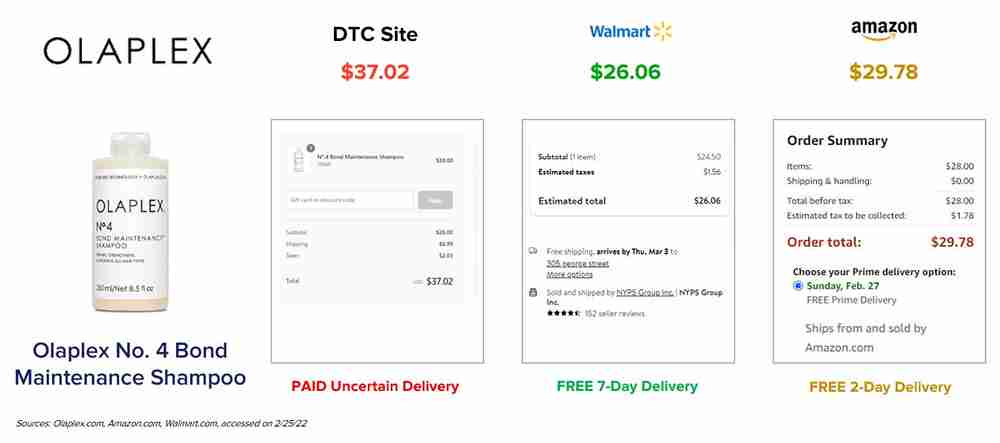
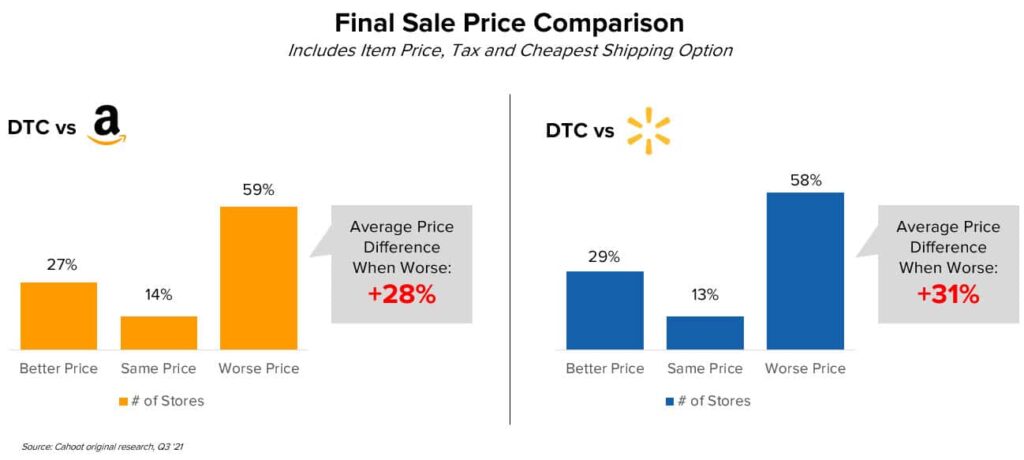
Why Should You Sell on Marketplaces?
Katie Burr, Senior Client Strategy Manager at ChannelAdvisor, helped flesh out our perspective on the huge edge that marketplaces enjoy.
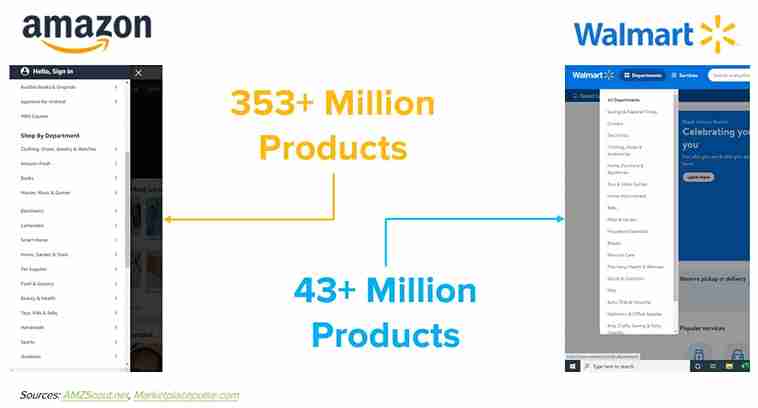
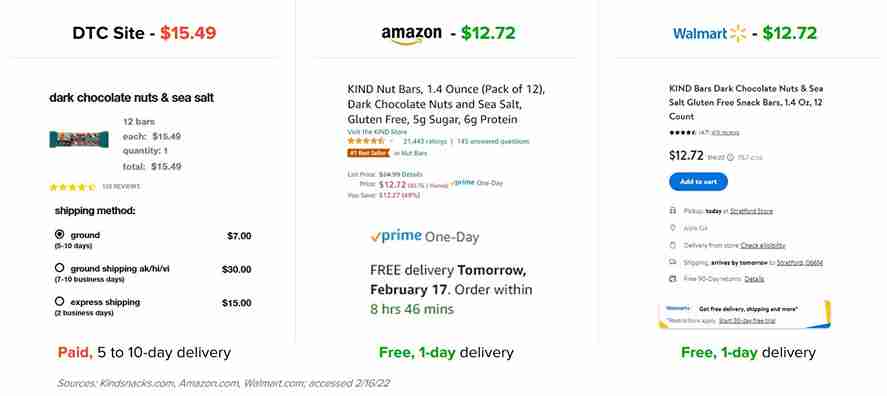
Why Should You Have a DTC Site?
Sharon Gee, VP of Revenue Growth at BigCommerce, ran through an impressive list of benefits that DTC sites bring to online brands.
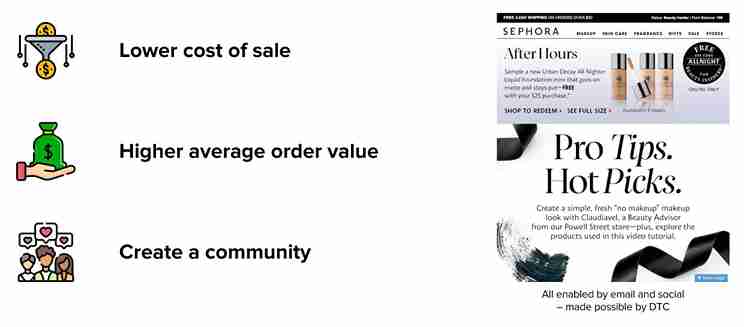
Why Is Multichannel Ecommerce So Powerful?
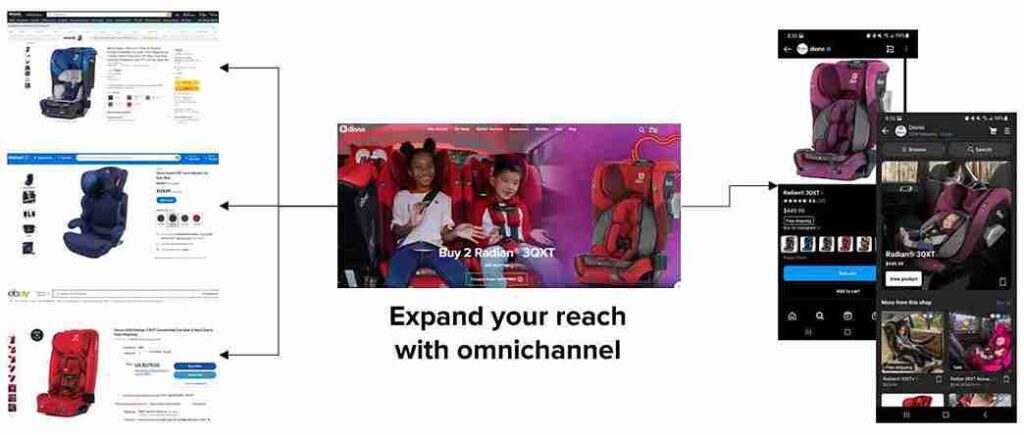
How Can You Grow With Multichannel Ecommerce?

Why You Need to Close The Order Fulfillment Gap
How Brands Can Level The Playing Field

Recap
Speakers




